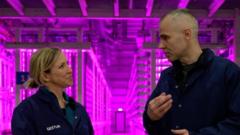As the global quest for sustainable food intensifies, Iceland's Vaxa Technologies is taking a futuristic approach to farming. By integrating microalgae cultivation with geothermal energy, the Vaxa facility aims to produce nutritious food while showcasing a carbon-negative model that could influence the future of agriculture.
Iceland's Vaxa Technologies: Pioneering Microalgae Farming for Sustainable Food Solutions

Iceland's Vaxa Technologies: Pioneering Microalgae Farming for Sustainable Food Solutions
Vaxa Technologies is revolutionizing food production in Iceland by harnessing microalgae cultivation in conjunction with geothermal energy sources.
In the heart of Iceland, beneath the shadow of the nation’s biggest geothermal power station, lies an extraordinary indoor farm unlike any other—and it is redefining food production. Vaxa Technologies has created a cutting-edge facility where vibrant microalgae thrive under artificial pink-purple lighting, harnessing eco-friendly resources to grow this promising nutritional powerhouse.
“This is a new way of thinking about food production,” says Kristinn Haflidason, general manager at Vaxa, as he offers a tour of this avant-garde establishment. While seaweed has long been a staple in diets around the world, its smaller counterpart, microalgae, has not captured the same attention despite being consumed in some cultures through the ages. Now, as scientists and innovators seek sustainable solutions, microalgae is being heralded as a potential dietary game-changer.
Located just outside Reykjavik, the Vaxa facility specializes in the production of Nannochloropsis, a microalgae rich in protein and omega-3 fatty acids, along with Arthrospira, commonly known as spirulina. Dried spirulina is utilized in dietary supplements and food products, recognized for its health benefits. “The algae consumes CO2, turning it into biomass,” explains Haflidason. “We are essentially carbon-negative.”
What sets Vaxa apart is its strategic integration with the nearby geothermal power plant, which not only provides clean electricity but also offers cold water for algae growth and hot water for heating. “This special location allows us to adopt a significantly lower carbon footprint for our operations,” states Asger Munch Smidt-Jensen, a food technology consultant who studied the environmental impacts of Vaxa's processes.
At the Vaxa facility, rows of photo-bioreactors—modular units filled with red and blue LED lights—sustain the algae’s growth in an optimized environment keenly monitored through machine learning. The operation is efficient, with about 7% of the crop harvested daily and the facility capable of producing up to 150 metric tonnes of algae annually. Plans for expansion are underway, with the potential to positively impact global food insecurity.
With an estimated market value projected to reach $25.4 billion by 2033, microalgae is garnering interest from various startups and industries. Innovations include portable photo-bioreactor units designed to connect with carbon-emitting industries, capturing CO2 while producing food and feed.
Yet, challenges remain before microalgae can make a regular appearance on dining tables. Concerns over texture and flavor persist, fending off widespread acceptance among consumers. “The texture can be firm, and some varieties have a fishy taste,” admits Munch Smidt-Jensen. Food scientists like Malene Lihme Olsen from Copenhagen University advocate for more research into enhancing microalgae's digestibility and nutritional value, suggesting that the best path forward may involve incorporating it into familiar food products.
Back in the production area, the recently harvested microalgae resembles an unappealing green sludge. Encouraged by Haflidason, I take a taste and discover a neutral flavor with a texture reminiscent of tofu. “We are certainly not suggesting people eat it in this form,” he laughs, emphasizing that processed algae will be an ingredient to boost the nutritional values of common foods—such as spirulina-infused breads and smoothies.
As Vaxa Technologies continues to push the boundaries of sustainable agriculture, they exemplify a future where food production is smart, efficient, and environmentally friendly, urging us all to reconsider what our diet might entail in a changing world.





















